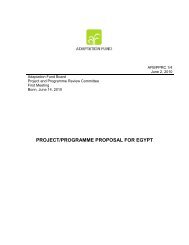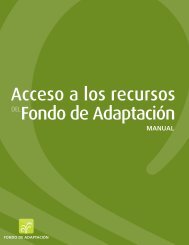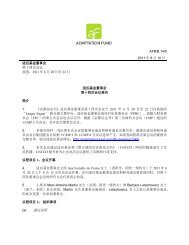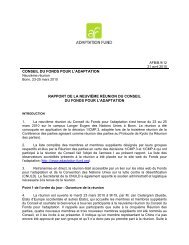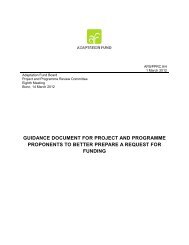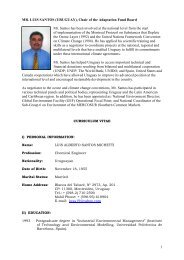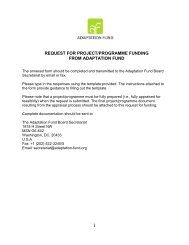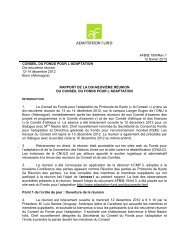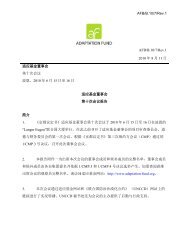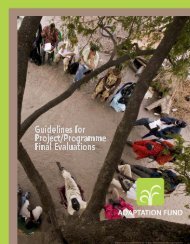PROPOSAL FOR MALI - Adaptation Fund
PROPOSAL FOR MALI - Adaptation Fund
PROPOSAL FOR MALI - Adaptation Fund
You also want an ePaper? Increase the reach of your titles
YUMPU automatically turns print PDFs into web optimized ePapers that Google loves.
induced stresses and their impacts on the diverse livelihoods of the local communities. Theweak local institutional capacity that prevails across all the pilot sites that seems to becontributing to the weak response capacity constitutes an important baseline for measuringprogramme impacts and progress in strengthening local institutional capacity in dealing withthe challenges. These were crucial in linking local institutional weaknesses to communitypoverty and vulnerability to food security as the expected in the proposed AF programme.Climate Change Accelerants and ImpactsThe Central/Sahelian region of Mali is the most sensitive to changes in rainfall, and mosthouseholds in this region derive over 70 percent of their income from the agriculture and/orlivestock sector, and are therefore the most vulnerable to climate change. This programmefocuses on the region of Mopti and Timbuktu including the Faguibine system in theCentral/Sahelian region of Mali and on those communities found to be most vulnerable toclimate change by the Comprehensive Food Security and Vulnerability Analysis (CSFVA)conducted by WFP using the following indicators 21 :- Production: lowest diversification in crops grown, or in classes of animals owned- Consumption: lowest percentage of food consumed from own production- Expenditures: highest percent of income spent on nutrition and second largest percapita expenditure on non-food items- Coping strategies: highest reliance on food-based coping strategies to mitigate shocksThe analysis of the Comprehensive Food Security and Vulnerability Analysis (CFSVA) andclimate data also indicates a close correlation between rainfall and food production for themajor crops in the region. This suggests that significant changes in rainfall would negativelyaffect food production in the absence of adaptation measures.With increasing unpredictability in the water flowing into the system, the Faguibine will losethe advantage of being relatively more food-secure than neighboring zones. Rice is thedominant crop, both in terms of production (incomes) and household consumption, followedby millet, sorghum and maize. Most rice is cultivated through submersion and thereforehighly dependent on water flows. Only a small proportion of rice is irrigated. While controlledirrigation would increase and stabilize yields, irrigation is uncommon due to high investmentcosts. For all crops, poor climate conditions and irregular rainfall combined with traditionalagricultural practices limit agricultural productivity to average yields of only 1.5 metric tonsper ha. The basic diet in the area is generally cereals (millet and rice) with little varietybecause of low levels of vegetable production. 22 However, livestock breeding is an importantlivelihood activity in the region of Mopti and Timbuktu. The main species that depend on theLake include bovines, goats and mutton. Among these, bovines have the highest economicvalue and only the wealthier groups own them.The poorest households especially suffer in the pre-harvest period of July-October due to alack of cereal stock and cash from the previous harvest season. During this period, whichalso sees the highest rates of migration to urban areas, prices for local or imported riceincrease by up to 17 percent, while those for millet, sorghum or maize increase by 33-39percent (national figures). These months are also those with the highest production of cattlemilk, after the new births of calves between June and August as well as through theimprovement in grazing land from increasing rainfall. The main harvest period is between21 Analysis of Livelihood Sensitivities to Climate in Mali, WFP, March, 2011 (Draft)22 Comprehensive Food Security and Vulnerability Assessment (CFSVA) for Mali, a detailed food security andvulnerability baseline conducted by the Government, WFP and partners between 2007 and 2008.26



